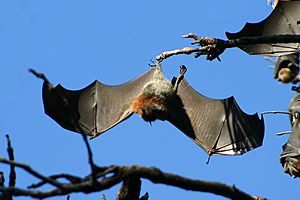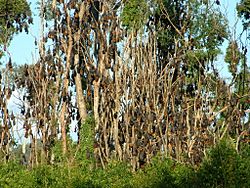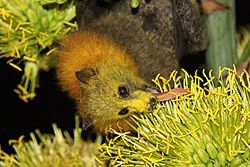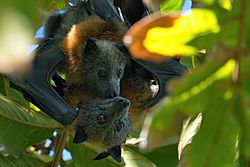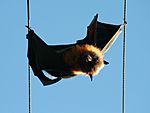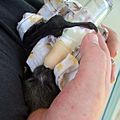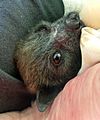Grey-headed flying fox facts for kids
Quick facts for kids Grey-headed flying fox |
|
|---|---|
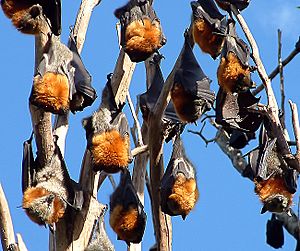 |
|
| Conservation status | |
| Scientific classification | |
| Genus: |
Pteropus
|
| Species: |
poliocephalus
|
 |
|
| Native distribution of Pteropus poliocephalus | |
The grey-headed flying fox (Pteropus poliocephalus) is a megabat native to Australia. The species shares mainland Australia with three other members of the genus Pteropus: the little red P. scapulatus, spectacled P. conspicillatus, and the black P. alecto.
The grey-headed flying fox is endemic to the south-eastern forested areas of Australia, principally east of the Great Dividing Range. Its range extends approximately from Bundaberg in Queensland to Geelong in Victoria, with outlying colonies in Ingham and Finch Hatton in the north, and in Adelaide in the south. In the southern parts of its range it occupies more extreme latitudes than any other Pteropus species.
As of 2008 the species is listed as "Vulnerable" on the IUCN Red List of Threatened Species.
Contents
Taxonomy
A description of the species was published by Coenraad Temminck in his 1825 monograph of mammals. Hybridisation with the species Pteropus alecto has been noted where their ranges intersect.
The common names for Pteropus poliocephalus include grey-headed kalong. The entry in Gould's Mammals of Australia (1863) gave the bat the title grey-headed vampire.
Description
The grey-headed flying fox is the largest bat in Australia. The overall colour of the pelage is a dark-grey body with a light-grey head, separated by a reddish-brown collar. The fur on the body is long and streaked with grey, the broad and well defined collar completely encircles the neck with hair that is golden orange in tone. A unique characteristic among bats of the genus Pteropus is fur on the legs that extends all the way to the ankle. Adults may have a wingspan reaching one metre in length and be up to one kilogram in weight. Weight generally varies between 600 and 1000 grams, with an average of 700 g.
The combined length of the head and body is from 230 to 290 mm. The forearm length is a range from 138 to 180 mm. The length of the ear from the tip to base is 30 to 37 mm. Like many megachiropterans, the species lacks a tail. All of these bats possess claws on its first and second digits. The head is simple in form, with the characteristic 'dog-like' appearance of the genus. Since it does not echolocate, it lacks the tragus or leaf ornamentation found in many species of Microchiroptera. It relies on smell and, predominately, sight to locate its food (nectar, pollen and native fruits) and thus has relatively large eyes for a bat.
The voice of P. poliocephalus consists of a complex series of squeals and screechings. They will flap their wings in hot weather, using blood pumped through the patagium to cool the body temperature.
The grey-headed flying fox is long-lived for a mammal of its size. Individuals reportedly survived in captivity for up to 23 years, and a maximum age of up to 15 years seems possible in the wild.
Ecology
Distribution
The distribution range is at the eastern regions of the Australian continent, mostly within 200 kilometres of the coast, from Gladstone in Queensland through to the southern Gippsland region and populations around the city of Melbourne. The breeding range has been recorded as progressing southward, the temperate climate of Melbourne and Geelong and no further north than Maryborough, Queensland.
Urbanisation may displace the species, or provide habitat that accommodates their feeding or roosting preferences. The city of Brisbane has many roosts occupied by the species; a famous colony at the Indooroopilly Island is noted for the evening departure of the bats across the local river. Within the central business district of Sydney, they can be seen travelling along city streets to feed at Moreton Bay fig trees at Hyde Park. The species was recorded as an occasional visitor to the national capital Canberra, although the flowering eucalypts at Commonwealth Park have seen more permanent camps established close to the city.
The species was surveyed during the 1920s by Francis Ratcliffe, who recorded the populations in estimates of quarter, half, or one million in camps, generally located around 40 kilometres apart. These numbers have greatly declined since this first survey.
Habitat and movements
Grey-headed flying foxes live in a variety of habitats, including rainforests, woodlands, and swamps. These camps are variable in size and are seasonally relocated; the warmer parts of the year find them occupying cool and wet gullies in large groups. During the day, individuals reside in large roosts (colonies or 'camps') consisting of hundreds to tens of thousands of individuals. Colonies are formed in seemingly arbitrary locations. Roost vegetation includes rainforest patches, stands of melaleuca, mangroves, and riparian vegetation, but roosts also occupy highly modified vegetation in urban areas. A prominent example existed for many years at the Royal Botanic Gardens in Sydney. However, the botanic gardens instituted a controversial policy to remove them from the garden grounds. The camp is now dispersed across Queensland.
Movements of grey-headed flying foxes are influenced by the availability of food. Their population is very fluid, as they move in response to the irregular blossoming of certain plant species. They are keystone pollinators and seed dispersers of over 100 species of native trees and plants. The grey-headed flying fox is a partial migrant that uses winds to facilitate long-distance movement. It does not migrate in a constant direction, but rather in the direction that will be the most beneficial at the time.
Although recorded in small numbers sporadically throughout the 20th century, it was not until the 1980s that grey-headed flying foxes routinely visited Melbourne, with a permanent camp since the 1990s. Their residence at the Melbourne Botanic Garden was the subject of controversy, and the bats were eventually discouraged and moved to Yarra Bend at the city's river. The camp at this site was decimated during a heat wave, requiring its rehabilitation to sustain the relocated population. The forced relocations are also said to have led to the discovery of the orchards of the Goulburn Valley. Similarly, the first recorded permanent camp in Adelaide was established in 2010. The spread is likely due to global warming, habitat loss and drought; while the location of the new camps appears to be in response to urbanisation: a reliable food supply (such as native eucalypt plantings and backyard fruit trees) and warmer temperatures due to climate change and urban heat islands.
Diet and foraging
Around dusk, grey-headed flying foxes leave the roost and travel up to 50 km a night to feed on pollen, nectar and fruit. The species consumes fruit flowers and pollens of around 187 plant species. These include eucalypt, particularly Corymbia gummifera, Eucalyptus muelleriana, E. globoidea and E. botryoides, and fruits from a wide range of rainforest trees, including members of the genus Ficus. These bats are considered sequential specialists, since they feed on a variety of foods. Grey-headed flying foxes, along with the three other Australian flying fox species, fulfill a very important ecological role by dispersing the pollen and seeds of a wide range of native Australian plants. The grey-headed flying fox is the only mammalian nectarivore and frugivore to occupy substantial areas of subtropical rainforests, so is of key importance to those forests.
The teeth, tongue and palate of the pteropodid bats are able to extract plant juices from food, only swallowing smaller seeds of the meal. Incisors hold items such as fruit, and the fibrous material is ejected from the mouth after it is masticated and the juice is swallowed; larger seeds may be held in the mouth and dispersed several kilometres from the tree. The need for the elaborate intestinal tract of most herbivores is consequently removed. Some fruiting plants produce food for flying-foxes, and P. poliocephalus is attracted to the scent of their flowers and fruit and is able to locate the pale colour that indicates the source; the fruit and blooms of species that attract birds in the daylight are usually contrasting reds and purples. The food source is also presented away from the foliage that may obstruct the bat's access.
Most of the trees on which this species forages produce nectar and pollen seasonally and are abundant unpredictably, so the flying fox's migration traits cope with this. The time when flying foxes leave their roosts to feed depends on foraging light and predation risk. Flying foxes have more time and light when foraging if they leave their roosts early in the day. The entire colony may leave later if a predatory bird is present, while lactating females leave earlier. With males, the bachelors leave earlier than harem-holding males, which guard and wait until all their females have left. The flying foxes that leave the roost earlier are more vulnerable to predation, and some flying foxes will wait for others to leave, a phenomenon labelled the "after you" effect.
Social organisation
Groupings and territories
Grey-headed flying foxes form two different roosting camps, summer camps and winter camps. Summer camps are used from September to April or June. In these camps, they establish territories, mate, and reproduce. Winter camps are used from April to September. The sexes are separated in winter camps and most behaviour is characterised by mutual grooming. Summer camps are considered "main camps", while winter camps are referred to as "transit camps".
In their summer camps, starting in January, male grey-headed flying foxes set up mating territories. Mating territories are generally 3.5 body lengths along branches. These flying foxes' neck glands enlarge in males in the mating season, and are used to mark the territories. The males fight to maintain their territories, and this is associated with a steep drop in the males' body condition during this time. Around the beginning of the mating season, adult females move from the periphery towards the central male territories where they become part of short-term 'harems' that consist of a male and an unstable group of up to five females. Centrally located males are polygamous, while males on the periphery are monogamous or single. The mating system of the grey-headed flying fox is best described as a lek because males do not provide any essential resources to females and are chosen on the basis of their physical location within the roost, which correlates with male quality.
Reproduction
Matings are generally observed between March and May, but the most likely time of conception is April. Most mating takes place in the territories and during the day. Females have control over the copulation process, and males may have to keep mating with the same females. Females usually give birth to one young each year. Gestation lasts around 27 weeks, and pregnant females give birth between late September and November. Late births into January are sometimes observed. The altricial newborns rely on their mothers for warmth. For their first three weeks, young cling to their mothers when they go foraging. After this, the young remain in the roosts. By January, young are capable of sustained flight, and by February, March or April are fully weaned.
Predation
Flying foxes are preyed on by eagles, goannas and snakes.
The camps of P. poliocephalus attract a number of larger predators. including both terrestrial and aerial hunters. The sea eagle Haliaeetus leucogaster will capture these bats in flight as they leave their roosts. The snake species Morelia spilota is frequently found as a resident at these camps, lazily selecting an individual from the apparently unconcerned group at a branch. The bat is seized in the jaws and encircled by the python's body, then swallowed head first to be digested over the next week. The species was reported by John Gould as being eaten by the indigenous Australians.
Conservation
The grey-headed flying fox is now a prominent federal conservation problem in Australia. Early in the last century, the species was considered abundant, with numbers estimated in the many millions. In recent years, though, evidence has been accumulating that the species is in serious decline. An estimate for the species in 2019 put the number at 586,000 and the national population may have declined by over 30% between 1989 and 1999 alone.
Threats
Grey-headed flying foxes are exposed to several threats, including loss of foraging and roosting habitat, competition with the black flying fox, and mass die-offs caused by extreme temperature events. When present in urban environments, grey-headed flying foxes are sometimes perceived as a nuisance. Cultivated orchard fruits are also taken, but apparently only at times when other food items are scarce. Because their roosting and foraging habits bring the species into conflict with humans, they suffer from direct killing of animals in orchards and harassment and destruction of roosts. Negative public perception of the species has intensified with the discovery of three recently emerged zoonotic viruses that are potentially fatal to humans: Hendra virus, Australian bat lyssavirus and Menangle virus. However, only Australian bat lyssavirus is known from two isolated cases to be directly transmissible from bats to humans. No person has ever died from ABLV (Lyssavirus) after having had the ABLV post-exposure vaccine.
The urbanised camps of cities were noted as succumbing to poisoning during the 1970s to 1980s, identified as the lead in petrol that would accumulate on the fur and enter the body when grooming. The mortality rate from toxic levels of lead in the environment dropped with the introduction of unleaded fuel in 1985. An introduced plant, the cocos palm Syagrus romanzoffiana, now banned by some local councils, bears fruit that is toxic to this species and has resulted in their death; the chinese elm Ulmus parvifolia and privet present this same hazard. The species is vulnerable to diseases that may kill large numbers within a camp, and the sudden incidence of premature births in colonies is likely to significantly impact the re-population of the group; the cause of these disorders or diseases in unknown. Unsuitable backyard fruit tree netting also kills many animals and may bring them into close contact with humans, but can be avoided by using wildlife-safe netting. Barbed wire accounts for many casualties; this can be ameliorated by removing old or unnecessary barbed wire or marking it with bright paint.
Recent research has shown, since 1994, more than 24,500 grey-headed flying foxes have died from extreme heat events alone. To answer some of the growing threats, roost sites have been legally protected since 1986 in New South Wales and since 1994 in Queensland. In 1999, the species was classified as "Vulnerable to extinction" in The Action Plan for Australian Bats, and has since been protected across its range under Australian federal law. As of 2008[update] the species is listed as "Vulnerable" on the IUCN Red List of Threatened Species.
The early twentieth century saw the incursion of Pteropus poliocephalus to the opportunities they discovered at orchards, and the government placed a bounty on the declared pest. Their reputation for destroying fruit crops was noted by John Gould in 1863, though the extent of actual damage was often greatly exaggerated. When Ratcliffe submitted his report, he noted the number of paid bounties was 300,000, and this would not have included the mortally wounded escapees or those left suspended at roosts by the grip that is held by their weight. This species continued to be killed or wounded by shotguns, many remaining disabled where they fell after the bounty was stopped, despite the advice of Ratcliffe and later researchers on an ineffective and uneconomical practice and the needless extermination of the population. Orchardists have begun shifting to the use of netting that also discourages the daytime visits of birds. The impact of indiscriminate shooting of bats has resulted in the species being declared vulnerable to extinction, to the tree species that relied on them for regeneration, the subsequent alteration to the forest ecology of the eastern states
Wildlife rescue
Bat caregivers are not only specially trained in techniques to rescue and rehabilitate bats, but they are also vaccinated against rabies. Although the chance of contracting the rabies-like Australian bat lyssavirus is extremely small, bat caregivers are inoculated for their own protection.
Flying foxes often come to the attention of Australian wildlife care and rescue organisations, such as Wildcare Australia, ONARR, Wildlife Carers Darling Downs, Bat Care, Bat Rescue, F.A.W.N.A. (NSW) Inc., Wildlife ARC, Northern Rivers Wildlife Carers, Northern Tablelands Wildlife Carers, Hunter Wildlife Rescue, Wildlife Aid, Tweed Valley Wildlife Carers, Wildlife Rescue South Coast, WIRES, and Wildlife Victoria when reported as injured, sick, orphaned, or abandoned. A very high proportion of adult flying fox injuries are caused by entanglement in barbed wire fences or backyard fruit tree netting, both of which can result in very serious injuries and a slow, agonising death for the animal if not rescued quickly. More recently wildlife advocacy groups such the Victorian Advocates for Animals has used the commercial development of a range of wildlife safe fruit tree netting products to push for regulations to make it illegal to install wildlife unsafe nets on backyard fruit trees. These new products have as their chief characteristic small apertures / holes of 5mm x 5mm or less. Flying foxes are able to climb across the netting without being entangled. It is hoped the uptake of wildlife safe netting products will see a marked decline in flying fox entanglements across time and subsequent reduction in public risk and the burden on wildlife rescue and rehabilitation volunteers. An emerging key threatening process to threatened flying-fox populations is the increasing numbers of days when temperatures exceed 41 °C, causing mass mortalities in flying-fox camps throughout their range along Australia's eastern seaboard.
Baby flying foxes usually come into care after having been separated from their mothers. Babies are often orphaned during four to six weeks of age, when they inadvertently fall off their mothers during flight, often due to disease or tick paralysis (their own and/or that of the mother). When they are older, orphans usually come into care because of maternal death from power line electrocution or barbed wire entanglement. A rare, but apparent natural, occurrence of mass abandonment can lead to the rescue of hundreds of babies at one time. The latter most recently occurred in November 2008 at the Canungra bat camp in South East Queensland, when Wildcare Australia, working closely with the EPA and regional bat care groups, rescued and rehabilitated over 300 baby grey-headed flying foxes. Most babies are in a dehydrated and distressed state by the time they are rescued, and some are infested with maggots if found sick or injured. A young flying fox must be fed every four hours, and then as it develops it is introduced to blossoms and fruit. When the young flying fox is fully weaned around 10 to 12 weeks of age, it goes into a crèche for rehabilitation and eventual release. The NSW Office of Environment and Heritage licences NSW rehabilitation groups under its Biodiversity Conservation Act 2016 and rehabilitation workers to the Code of Practice for Sick, Injured and Orphaned Flying-foxes developed in partnership with NSW Wildlife Council groups and WIRES.
Gallery
-
Grey-headed flying foxes in Royal Botanic Gardens, Sydney
-
Grey-headed flying fox with baby (the smaller bat in the back is a little red flying fox
- ARKive - images and movies of the grey-headed flying-fox (Pteropus poliocephalus)
See also
 In Spanish: Pteropus poliocephalus para niños
In Spanish: Pteropus poliocephalus para niños



